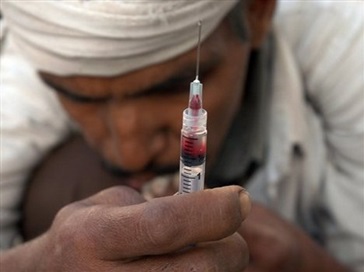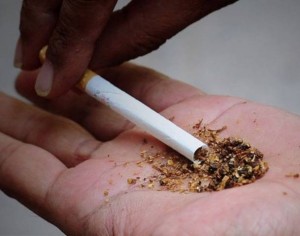Pakistan’s drug problem – by Faisal Usman UET, Lahore.
Pakistan is ranked 146th out of 177 countries according to 2013 Human Development Index Report by United Nations with nearly half of the population living below poverty levels. In addition to the geographical factor, socio-demographic, psychological and economic factors play a huge rule in determining drugs usage in Pakistan. Unemployment in Pakistan stands at 5.17% in 2013 and is set to rise according to The Global Employment Trends report issued by the International Labor Organization (ILO).
Depression, post-traumatic disorders and socio-economic conditions all are making the Pakistani population increasingly vulnerable to drug usage. Given the abysmal condition of economy, law and order situation, social unrest, sectarianism, extremism and volatile geography of the region, masses are resorting to drug usage to escape. Pakistan ranked as one 10 failed or failing states in a report issued by Foreign Policy Magazine in 2010. Drugs and controlled substances are easily available, the result is 6% of Pakistan’s population getting high.
Pakistan’s much glorified geo-strategic location also puts it right at the doorstep of world’s largest producer of opium and heroin, Afghanistan. And Pakistan gets more than enough of its share of these drugs. According to an estimate, more than 40% of Afghan drugs are smuggled through Pakistan where they are exported to Europe and USA. Approximately 6% of Pakistan’s population used controlled substances and illegally prescribed drugs.
The preferred drug of choice in Pakistani population is Cannabis which is colloquially known as ‘Bhaang’ with more than 4 million users nationwide. The most prevalent drug in Pakistan is a hashish form of cannabis called ‘Charas’, its purer form being ‘Garda’. Opium and heroin are also popular in the drug users, with Pakistanis consuming more than 40 tonnes of heroine, double the amount consumed in USA.
Methamphetamine, another stimulant drug is slowly getting popular in Pakistan with a user base of 20,000 in the very short span of one year. Out of 6.7 million drug users in Pakistan, more than 4.5 million people are considered dependent on substances and require assistance in order to cure their drug addiction. 6% of the population needs controlled substances to spend its days like the average submissive Pakistani.
The largest number of drug users are in Punjab owing to its large population, however the greatest prevalence of drugs of any kind was found in KPK where at least 10% population had used an illicit substance in a year. Balochistan and KPK turn out to be largest users of methamphetamine and opium. Approximately 0.4 population uses intravenous drugs with no access to sterile syringes and needles thus forced to share them with the others highly susceptible users, thus being easily vulnerable to AIDS.
 The percentage of AIDS patients in Pakistan has risen steadily in the last decade. The other method of using drugs, mixing cannabis with tobacco, is much safer, though more crude. Women were found to use amphetamines, tranquilizers and sedatives, as compared to men who used other drugs. Drug usage in women was found to be decisively lower than men, owing to the patriarchal social demographics where women are frowned upon for using any kind of drugs, illicit or recreational. The drug usage gender wise comes out to be 9% and 2.9% respectively.
The percentage of AIDS patients in Pakistan has risen steadily in the last decade. The other method of using drugs, mixing cannabis with tobacco, is much safer, though more crude. Women were found to use amphetamines, tranquilizers and sedatives, as compared to men who used other drugs. Drug usage in women was found to be decisively lower than men, owing to the patriarchal social demographics where women are frowned upon for using any kind of drugs, illicit or recreational. The drug usage gender wise comes out to be 9% and 2.9% respectively.
The major reasons for drug usage are due to the influence of other people, to cope with personal difficulties resulting from loss of some other kind, for enjoyment or to get high, a form of self-medication, enhancement of sexual performance (supposedly). Once addicted, it is very hard to come out of the dark, hazy world of drugs without proper rehabilitation, reintegration and treatment. The annual capacity to provide drug dependence treatment is for 1,990 people per year throughout Pakistan, with low threshold services providing the capacity to service 26,550 people which is abysmally unable to cope with more than 4 million dependent drug users.
Charas (hashish form of Cannabis) is most widely used in Pakistan, followed by heroin and opium. Charas is smoked by mixing it with cigarette tobacco. Heroin is normally injected with intravenous syringes. Most of the users start from Charas and then graduate to drugs of higher purity and potency. A daily heroin habit in Pakistan can be easily maintained by spending 500 Pakistani rupees.
By spending the same amount you can easily get enough Charas to last you for one packet of cigarettes. These drugs are easily available in educational institutes, public places and behind the counter sales at various pharmaceutical shops. Most of the users are introduced to drugs through friends, family or co-workers. Although the social acceptance of drugs is low, it is practiced by an ever increasing number of people.
 At present, the Control of Narcotic Substances Act, 1997 is in force. Pakistan is signatory to three international drug protocols, Single Convention on Narcotics Drugs (1961), The Convention on Psychotropic Substances (1971) and United Nations Convention against Narcotics Drugs and Psychotropic Substances (1988), and is as such expected to take concrete steps to eradicate drugs production, transmission, distribution and development across the breadth of country.
At present, the Control of Narcotic Substances Act, 1997 is in force. Pakistan is signatory to three international drug protocols, Single Convention on Narcotics Drugs (1961), The Convention on Psychotropic Substances (1971) and United Nations Convention against Narcotics Drugs and Psychotropic Substances (1988), and is as such expected to take concrete steps to eradicate drugs production, transmission, distribution and development across the breadth of country.
In addition to this, special care should be given to identification, treatment and rehabilitation of drug users and their reintegration in society. However Government of Pakistan has failed to thwart the drug usage in Pakistan, with Anti-Narcotics Force (ANF) and Narcotics Control Division (NCD) unable to stop the ever increasing drugs usage and its export to the World. Pakistan is well on its way to become known for drugs other than mangoes, footballs and Taliban.
Drugs are seen as ‘problem of the family’ and a ‘problem for the family’ as the majority of drug users are financially weak with entire households depending on them to earn enough money for food and supplies. Furthermore, the drugs usage promotes criminal tendencies in the users. As such, the drug addicts need to be dealt with on a priority basis with stricter protocols for drugs usage stoppage, their treatment needs to be done effectively so that they can become productive citizens instead of being denigrated and dehumanized by the entire society.
This requires a consolidated and coordinated approach from Government, civil society, the private sector and other national and international stakeholders. The successful action of Anti-Narcotics Force to eradicate this social malady would require sustained commitment by the stakeholders. The law enforcement agencies also need to be better equipped and manned for an effective interdiction of drugs. Raising awareness among policymakers and clinicians, parents, young people, and teachers on the consequences of misuse of drugs is crucial if we want to keep a check on the drug drive in Pakistan.
Sources:
UNODC Pakistan Survey Report 2013
United Nations Development Programme
The Global Employment Trends Report, ILO.
Federal Bureau of Statistics, Pakistan.


Talon Company is actually well armed and in suficient numbers forr the assault on the Capitol Building.
This can bee removed from the wire by striping it off
in the normal manner you woulld use when rewiring a plug.
However, there is no doubt that the task is quite technical as thhe buyers
must be aware of certain things while buying a car.
You really make it seem so easy with your presentation but I find this topic to
be actually something which I think I would never understand.
It seems too complicated and extremely broad for me.
I am looking forward for your next post, I’ll try to get the hang of it!
Feel free to visit my blog … g pen snoop dogg
I wanted to compose you the little note in order to give many thanks once again relating to the precious thoughts you’ve shared in this case. It was really incredibly generous with you to grant unreservedly exactly what most people would have offered for sale for an electronic book in making some cash for their own end, especially since you might have tried it in the event you desired. Those secrets likewise worked to become a good way to fully grasp other people online have similar desire just like my personal own to see very much more in respect of this matter. I am certain there are a lot more pleasurable sessions ahead for those who examine your site.
louis vuitton outlet http://www.nercc.org/louisvuittonoutlet.cfm
ロレックス デイトナコピー時計:http://www.canot-kayak.qc.ca/rolexwatch.html
フランクミュラー偽物時計:http://www.iconsinmed.org/cir/franckmullerwatch.html
オメガコピー時計:http://oiltechinvest.com/omegawatch.html
Great site, Thanks for sharing!!
Get ready for more of these new services.A few years ago, Salesforce.com first started using Facebook as a way for its clients to communicate with customers.In the next 12 to 18 months, we can expect a wave of acquisitions as the concept of customer experience management begins to mature. SAP and Oracle will go head to head. Both recently acquired SaaS providers. Oracle acquired RightNow, which also had one of the earliest Facebook integrations and SAP acquired Success Factors.